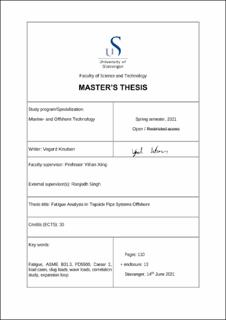| dc.description.abstract | Safety and reliability are terms generally associated with offshore oil and gas industry, particularly regarding piping where failure could potentially cause catastrophic outcomes. Hence, codes and standards have been developed to ensure a level of quality and reliability regarding engineering practice. Such standards include methodologies and procedures with respect to many applications, where fatigue analysis is a central topic, especially when determining the design life of a structure subdued to cyclic loading. Two prominent standards in the field of offshore piping are ASME B31.3 and PD5500, where the former in 2018 added an appendix addressing the subject of fatigue analysis through an alternate method. Therefore, it is of great interest to perform a comparative study, in which results obtained from both codes were analyzed. Thus, inputs required for both methodologies were gathered through application of nodal piping software Caesar 2, which was used, amongst others, to calculate stress ranges at points of interest. For this case study, the points of interest were the elbows of an expansion loop between two oil platforms. These elbows were subdued to cyclic loading from a combination of sources, including wave displacements, slugging, and fluctuations of pressure and temperature. After stress ranges from all sources had been gathered and applied with fatigue analysis according to both codes, the results were compared and further analyzed through correlation studies with respect to the different sources of cyclic loading. The findings of which indicated that the procedure of ASME B31.3 yielded an overall more conservative output regarding estimated lifetime of structure when compared to methodology of PD5500 with S-N curve connected to weld class D. An important contributing factor of which was the constants associated with S-N curves, particularly in the case of high cyclic loading, where the former code resulted in 14 % shorter life expectancy. The most crucial factor was the method applied for calculating damage due to wave displacements, where ASME B31.3 resulted in average of 5.45 times higher instances of accumulated damage. The latter point was underlined by further analysis where more conservative weld class from PD5500 were applied. Specifically, class F2, which resulted in an overall shorter life expectancy according to PD5500 with significantly less accumulated damage attributed to wave displacements. Lastly, results from this thesis implied different impact of wall thickness, where an increase resulted in more conservative output from ASME B31.3 relative to PD5500. The main proposed reason for which was the stress outputs corresponding with increasing wall thickness that showed larger stresses from wave loads, along with decreasing stresses from slug loads. | |
